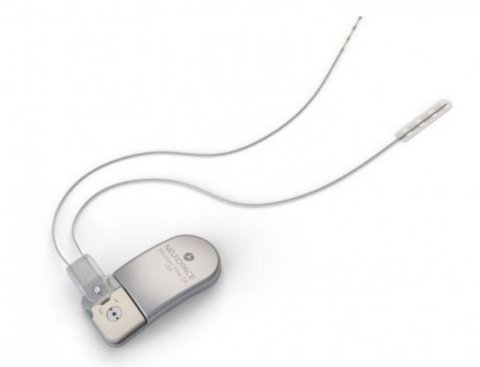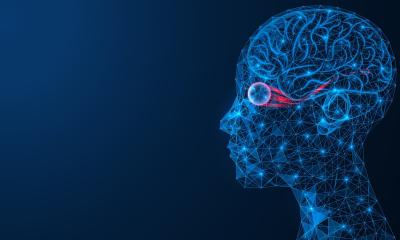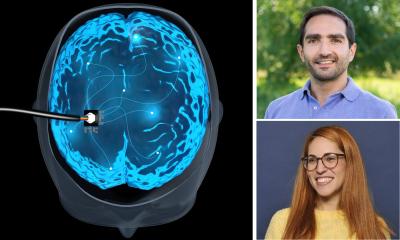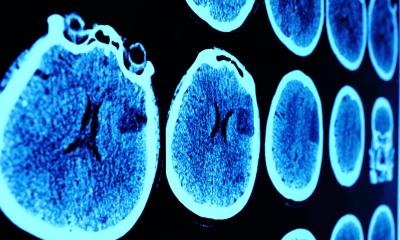Image credit: DR.UNIGE/ Mélanie Proix
News • Cloudy, with a chance of seizures
Creating a 'weather forecast' for epilepsy
Patterns of brain activity can be used to forecast seizure risk in epilepsy patients several days in advance, according to a new analysis of data obtained from clinically approved brain implants by neuroscientists at UC San Francisco, the University of Bern and the University of Geneva.
"For forty years, efforts to predict seizures have focused on developing early warning systems, which at best could give patients warnings just a few seconds or minutes in advance of a seizure. This is the first time anyone has been able to forecast seizures reliably several days in advance, which could really allow people to start planning their lives around when they’re at high or low risk,” said Vikram Rao, MD, PhD, a neurologist at the UCSF Epilepsy Center, part of the UCSF Helen Diller Medical Center at Parnassus Heights. Rao was co-senior author of the new study, which was published in The Lancet Neurology.
Epilepsy is a chronic disease characterized by recurrent seizures – brief storms of electrical activity in the brain that can cause convulsions, hallucinations or loss of consciousness. For decades, epilepsy researchers around the world have been working to identify patterns of electrical activity in the brain that signal an oncoming seizure, but with limited success. In part, study authors say, this is because technology has limited the field to recording brain activity for days to weeks at most, and in artificial inpatient settings.

Image credit: Rao lab
At the UCSF Epilepsy Center, a major referral center for patients throughout the Western United States, Rao has pioneered the use of an implanted brain stimulation device that can quickly halt seizures by precisely stimulating a patient’s brain at the first signs of an imminent seizure. This device, called the NeuroPace RNS System, has also made it possible for Rao’s team to study seizure-related brain activity recorded over many months or even years in patients as they go about their normal lives — typically unheard-of in neuroscience.

© zvg
By analyzing this data, Rao and Maxime Baud, MD, PhD, a former UCSF neurology resident who is now an epileptologist at the University of Bern and the Wyss Center for Bio- and Neurotechnology in Geneva, recently discovered that seizures are less random than they appear, identifying weekly-to-monthly cycles of “brain irritability” that predict higher likelihood of having a seizure.
In their new study, Rao and Baud set out to test whether these regular patterns could be used to create clinically reliable forecasts of seizure risk. “Currently, the perceived threat of seizures is constant for people with epilepsy, because no methods exist to identify times of high versus low risk,” said Baud, who was co-senior author on the new study. “This has very broad consequences for daily activities, including avoiding potentially dangerous situations, like bathing, cooking on a hot stove and participating in sports.”

© zvg
Led by Timothée Proix, PhD, of the University of Geneva, the researchers built statistical models matching patterns of recorded brain activity to subsequent seizures in 18 epilepsy patients with implanted NeuroPace devices being followed at UCSF and California Pacific Medical Center in San Francisco. They then tested these forecasting algorithms using data from 157 participants who participated in the multi-center Long-Term Treatment trial of the RNS System between 2004 and 2018.
Looking back at the trial data, the researchers were able to identify periods of time when patients were nearly 10 times more likely to have a seizure than at baseline, and in some patients, signs of these periods of heightened risk could be detected several days in advance.
Of course, elevated risk of a seizure does not necessarily mean a seizure will occur. Epileptologists still do not fully understand what causes a seizure to happen at a particular moment in time, though many individuals report reliable triggers such as stress, alcohol, missed medication doses, or lack of sleep. He likens the system to the predictive models used by weather forecasters, which we frequently use to make decisions about what clothes to wear and whether to bring an umbrella when going out.
“I don’t think I'm ever going to be able to tell a patient that she is going to have a seizure at precisely 3:17 pm tomorrow — that’s like predicting when lightning will strike,” said Rao, who is Ernest Gallo Foundation Distinguished Professor of Neurology in the UCSF Weill Institute for Neurosciences. “But our findings in this study give me hope that I may someday be able to tell her that, based on her brain activity, she has a 90 percent chance of a seizure tomorrow, so she should consider avoiding triggers like alcohol and refrain from high-risk activities like driving."
Currently, patients have absolutely no information about the future—which is like having no idea what the weather tomorrow might be—and we think our results could help significantly reduce that uncertainty for many people
Vikram Rao
Having accurate advance forecasts of seizure risk could also potentially allow neurologists to adjust patients’ medication dosage accordingly, the researchers say, keeping doses low most of the time to minimize side effects and only raising dosage during times of higher seizure risk.
The researchers found significant variability in how well future seizure risk could be predicted from study participants’ brain activity. While risk could be forecasted several days in advance in 40 percent of RNS System trial participants, other participants’ brain data only predicted the following day’s risk, and still others didn’t exhibit the activity cycles needed for reliable predictions at all.
More research is needed to interpret this variability, Rao says. The RNS System itself is designed to detect and avert imminent seizures, not for advance seizure prediction, so it’s possible that purpose-built devices could detect predictive fluctuations in brain activity in a broader spectrum of patients. Or it could be that epilepsy patients simply vary, as they do in many other respects, in the predictability of their risk cycles. “It is worth remembering that, currently, patients have absolutely no information about the future—which is like having no idea what the weather tomorrow might be—and we think our results could help significantly reduce that uncertainty for many people,” Rao said. “Truly determining the utility of these forecasts, and which patients will benefit most, will require a prospective trial, which is the next step.”
Source: University of California, San Francisco (UCSF) / Université de Genève / Universität Bern
18.12.2020











